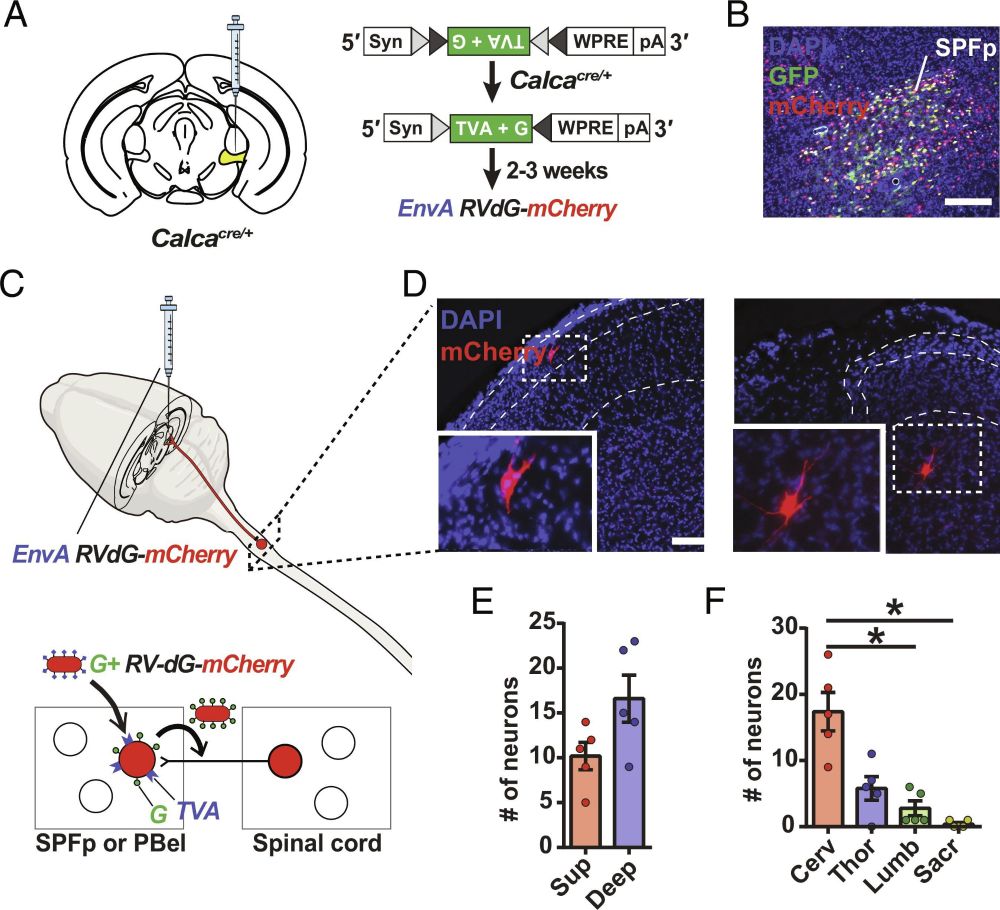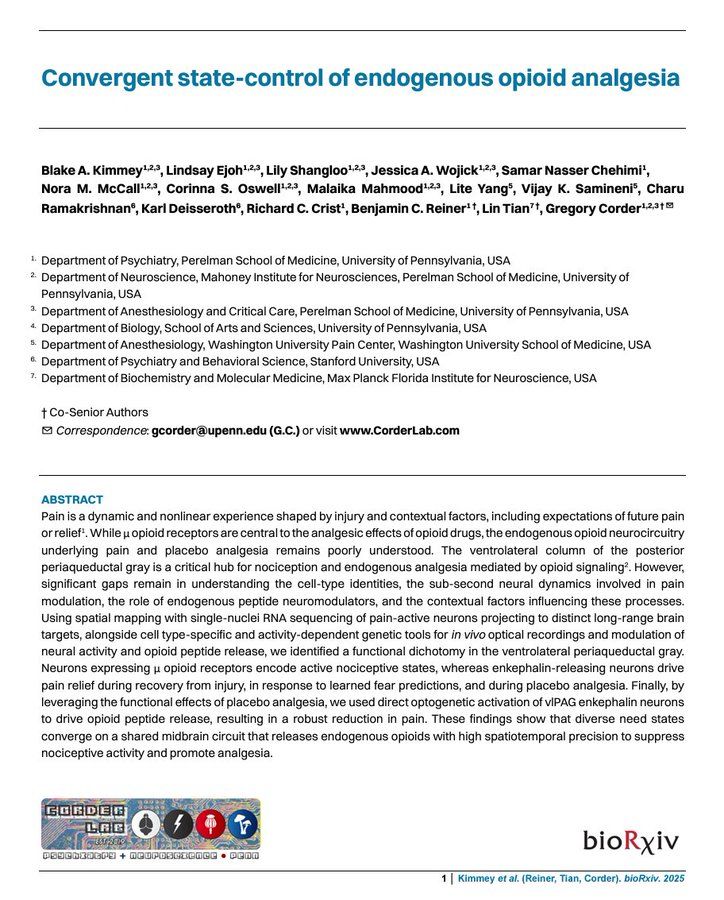
Thalamic CGRP neurons define a spinothalamic pathway for affective pain | PNAS
Pain is both a sensory and emotional experience caused by various harmful stimuli.
While numerous studies have explored peripheral and central pain...
New paper out in @pnas.org Thalamic CGRP neurons form a spinothalamic pain pathway relaying pain signal to the amygdala & insular, but not sensory cortex to encode the affective dimension of pain. Huge congrats to first author Sukjae Kang & coauthors. www.pnas.org/doi/10.1073/...
09.07.2025 22:58 — 👍 17 🔁 6 💬 0 📌 0

Psilocybin’s lasting action requires pyramidal cell types and 5-HT2A receptors - Nature
A pyramidal cell type and the 5-HT2A receptor in the medial frontal cortex have essential roles in psilocybin’s long-term drug action.
Our latest study identifies a specific cell type and receptor essential for psilocybin’s long-lasting neural and behavioral effects 🍄🔬🧠🧪
Led by Ling-Xiao Shao and @ItsClaraLiao
Funded by @NIH @NIMHgov
📄 Read in @nature.com - www.nature.com/articles/s41...
1/12
02.04.2025 16:09 — 👍 162 🔁 54 💬 13 📌 6
Congrats Greg and team!🎉🎊🎊
03.04.2025 15:21 — 👍 2 🔁 0 💬 1 📌 0
Amazing story! Congratulations, Greg and team!!!🎉🎊
05.01.2025 17:51 — 👍 1 🔁 0 💬 1 📌 0

1/ 🧠 Excited to share our new preprint:
Convergent state-control of endogenous opioid analgesia
We uncover how cognitive + contextual factors—like injury, fear, and placebo—modulate pain through dynamic opioid signaling in the periaqueductal gray (PAG)
biorxiv.org/content/10.1...
04.01.2025 17:24 — 👍 55 🔁 23 💬 4 📌 5

This is figure 1, which shows the identification of a cortical-to-brainstem slow breathing circuit.
A study in Nature Neuroscience identifies a prefrontal–pontomedullary pathway that slows breathing and reduces anxiety in mice. The findings explain a circuit basis for top-down control of breathing, which can influence emotional states. 🔒 https://go.nature.com/3CUtPy3
06.12.2024 20:02 — 👍 79 🔁 21 💬 0 📌 1
"Frequency-dependent transmitter switching" adds a new layer of complexity to neurotransmission, potentially uncovering how individual multi-transmitter neurons encode diverse information. Firing rate must be recognized as a crucial variable in optogenetics, as previously highlighted!
23.11.2024 18:25 — 👍 0 🔁 0 💬 0 📌 0

Encoding opposing valences through frequency-dependent transmitter switching in single peptidergic neurons
Peptidergic neurons often co-express fast transmitters and neuropeptides in separate vesicles with distinct release properties. However, the release dynamics of each transmitter in various contexts ha...
Some glutamatergic synapses show decreased release probability (Pr) at high firing rates due to vesicle depletion or VGCC feedback inhibition. In contrast, neuromodulator vesicles exhibit increased Pr, enabling frequency-dependent encoding of distinct information via transmitter switching.
23.11.2024 18:25 — 👍 4 🔁 1 💬 1 📌 0
Thank you for your kind words! I am very glad that you enjoyed reading it.
21.11.2024 02:53 — 👍 0 🔁 0 💬 0 📌 0
Thanks a lot!
21.11.2024 01:38 — 👍 0 🔁 0 💬 0 📌 0
Thank you, Tom!!!
20.11.2024 23:45 — 👍 0 🔁 0 💬 0 📌 0

Amy Cao
Excited to share my first post here! Our new paper reveals a top-down breathing circuit that slows breathing to ease anxiety & fear. A step forward in understanding how brain-breathing interactions shape emotion. Published in Nature Neuroscience—grateful to my team!
www.nature.com/articles/s41...
20.11.2024 19:02 — 👍 121 🔁 31 💬 12 📌 1
Associate Professor @ UCLA DGSOM. My lab studies mPFC neural circuits, learning and memory & early life stress. Mom of 2 humans and 1 dog, amateur chef, Peloton enthusiast.
Assistant Professor of Neurobiology @ University of Utah investigating the neuroscience of social behavior and emotion.
UCLA > Caltech > U Utah
https://www.zelikowskylab.com
Neurobiologist at the Max Planck Institute for Metabolism Research
www.sf.mpg.de/research/fenselau
Neuroscientist | BRAIN K99 Fellow at Princeton 🔜 Assistant Professor at Utah
https://zimmerman-lab.org
Neuroscientist studying the neural circuits of learning&memory and motivated behaviors. PI in the Do Monte lab at the @McGovernMed School UT Houston. Immigrant, dog lover, travel lover.
🇧🇷🇵🇷🇺🇸🐀🧠🦠🔬👨🏽🔬
https://sites.google.com/view/domontelab
Neuroscientist at Washington University in Saint Louis. Lab web site: https://sites.wustl.edu/yaochenlab/
Neuroscientist at UCSF / PhD / Interoception / Body-Brain-Interactions / Emotions
Neuroscientist. Laboratory of Sensory Perception
Professor and Chairman, Dept. Neurobiology,
University of Maryland School of Medicine
Views are my own
comp neuro, neural manifolds, neuroAI, physics of learning
assistant professor @ harvard (physics, center for brain science, kempner institute)
proj leader @ Flatiron Institute
https://sites.google.com/site/sueyeonchung/
A neuroscientist exploring the world of physiology
Ph.D candidate, Sung-Yon Kim’s lab @ SNU
Assoc Prof UTSW • Somatosensory Enthusiast • Lover of all things spinal • Kid and Dog Mom• helenlailab.org • Posts are my own
Husband, Father and grandfather, Datahound, Dog lover, Fan of Celtic music, Former NIGMS director, Former EiC of Science magazine, Stand Up for Science advisor, Pittsburgh, PA
NIH Dashboard: https://jeremymberg.github.io/jeremyberg.github.io/index.html
Assoc.Professor, Dept. of Neuroscience, UMN, progressive democrat, beagle mom, Minnesotan by way of the East Coast. Opinions are my own.
Neuropharmacologist & professor at UCI. Addiction Neuroscience, Graduate Education, Diversity & Inclusion, from Aberdeen, Scotland
Associate Professor at UC Irvine studying translational drug addiction, mechanisms & therapeutics. Neuroscientist, Fulbrighter, 6x Marathoner (3:27:34).
TEDx: youtu.be/Or7NeiJj2lw
lotfipourlab.org
UCIBTC.org
Account for the Carleton and Rodriguez laboratories at the university of Geneva, Switzerland. rodriguez-carleton-labs.unige.ch
Studying claustrum and cognitive dysfunctions in neuropsychiatric disorders.
Basic & translational neuroscience laboratory at University of Wisconsin-Madison studying the synaptic contribution to neuropsychiatric disorders 🧠🐭🔬| PI: Michael E. Cahill, PhD | Acct supported by lab members!
🔗 https://CahillLab.wiscweb.wisc.edu
Professor #neuroscience Scintillon Institute, Salk Institute (Adjunct); previously Nanyang Technological University, UCSF, Columbia University, University of Illinois Urbana-Champaign
https://www.chenlaboratory.us/
Neuroanatomy - Cognitive & Behavioral Neurology - Iowa Neuroscience Institute
Postdoc at Harvard with Bernardo Sabatini (EMBO fellow). Former PhD at the Netherlands Institute for Neuroscience with Ingo Willuhn.
Basal ganglia, neural computations, DBS, calcium imaging







